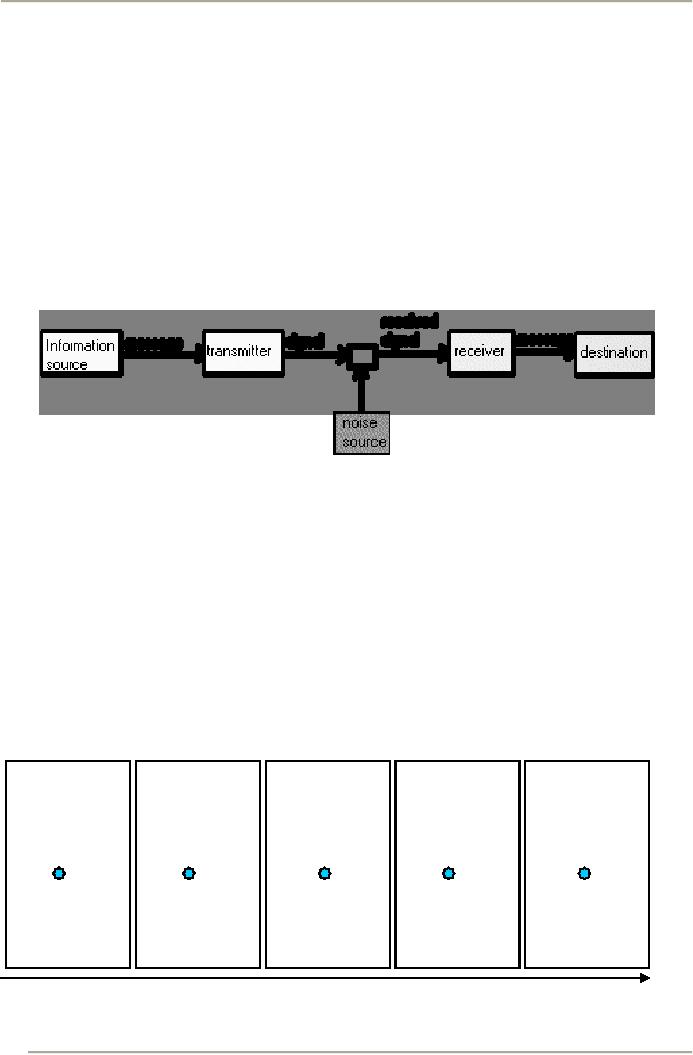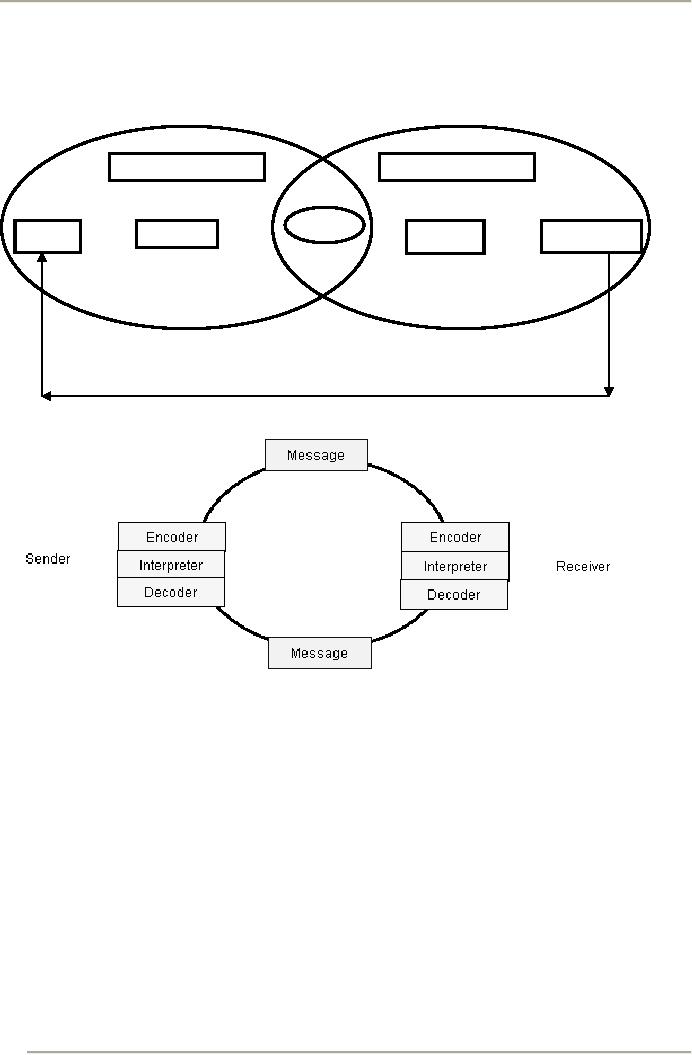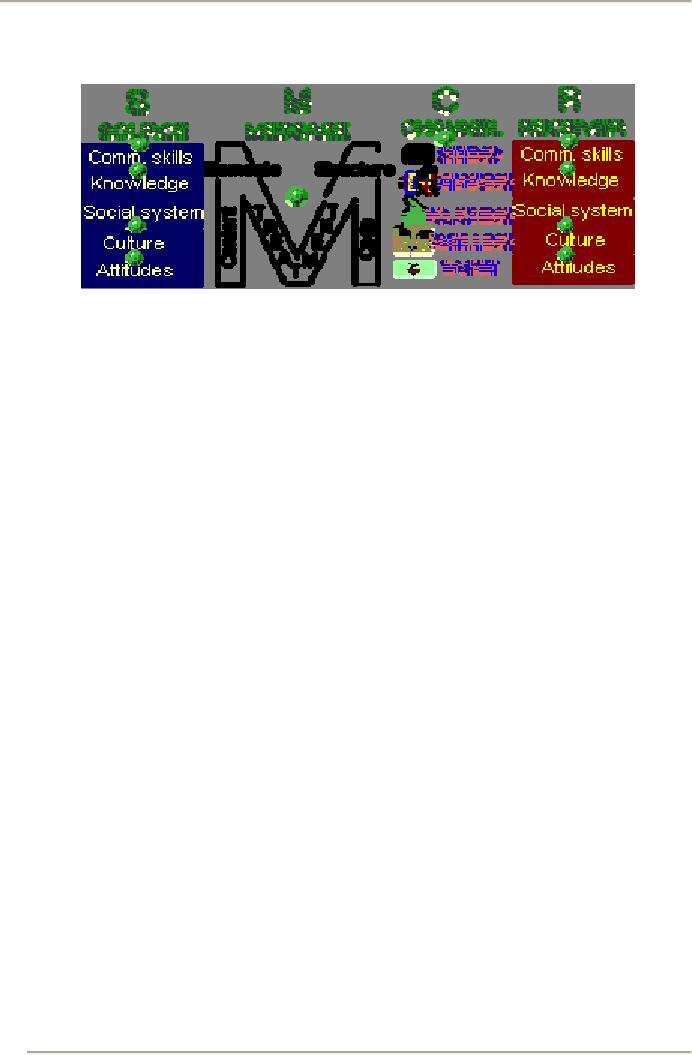 |
RECAP:Elements of communication, Books, Printing, Verbal Message |
| << RENAISSANCE AND SCIENTIFIC REVOLUTION: ROLE OF PRINT MEDIA:Science |
| MEDIA MANAGEMENT:Division, Business section, Press >> |

Introduction
to Mass Communication MCM
101
VU
LESSON
22
RECAP
Communication
sending of a message from
one person to another, in
simplest terms - has
been
one
of the oldest characteristics of human
life. Even when formal
languages were not
available, people were
able
to make each other
understand their feelings
and gestures to accomplish
routine tasks.
Why
we need communication?
�
Survival
�
Co-operation
�
Relationship
�
Persuasion
& Influence
�
Power
�
Social
needs
�
Information
Categorization
of Communication
�
Intra
personal Communication
�
Inter
personal Communication
�
Organizational
Communication
�
Group
Communication
�
Mass
Communication
Elements
of communication
�
Sender
�
Message
�
Channel
�
Receiver
�
Interpreter
�
Feedback
�
Context
Books
From
writing letters to very many people on
one subject, the next move
was to write books on
matters
of social life, philosophies, religion,
health and scientific advancements. The
hand-written books
continued
to rule the world for centuries by
taking views of writers to hundreds
and thousands of people
across
countries. For instance, the
central church in ROME had
employed hundreds of clerics
for the
purpose
of writing copies of bible
for taking the message of
Christianity to its followers. Almost the
same
had
been the practice by other religions to
convey their teachings to the
masses by hand-written copies
of
the
holy inscriptions. Many a museums in the
world are proud to have
some hand-written copies
of
religious
or scientific works done centuries
ago.
Printing
Major
breakthrough in mass communication
occurred when printing
process was invented.
The
revolutionary
invention makes an interesting
study:
The
printing press is a mechanical
device for printing many
copies of a text paper. First
invented in China in
1041,
the printing press as we know it today
was invented in the West by a German
goldsmith, Johann
Gutenberg
in the 1440s. Dutch Laurens
Janszoon Coster has also
been credited with this
invention.
�
Block
Printing
�
Printing
Press Johannes Gottenberg,
15th century
Communication
Model
69

Introduction
to Mass Communication MCM
101
VU
Communication
experts have long been
striving to arrange elements of
communication into some
graphic
arrangement so that all the complexities
of communication may come in view in a
glance. But
before
we try to examine them lets
try to understand what a model
is.
What
is a Model?
�
A model is a
systematic representation of an object or event in
idealized and abstract form.
Models
are
somewhat arbitrary by their
nature.
�
Communication
models are merely pictures;
they're even distorting pictures,
because they stop or
freeze
an essentially dynamic interactive or transitive
process into a static
picture.
�
Models
are metaphors. They allow us
to see one thing in terms of
another.
Shannon-Weaver's
Model of Communication
The
Shannon-Weaver's model is typical of what are
often referred to as transmission models
of
communication.
Claude Shannon and Warren
Weaver were two different
entities that jointly produced a
model
known after their
names.
Claude
Shannon and Warren Weaver produced a
general model of communication:
This
model is now known after them as the
Shannon-Weaver's Model. Although they
were principally
concerned
with communication technology,
their model has become one
which is frequently introduced
to
students
of human communication early in their
study.
The
Shannon-Weaver's Model (1947)
proposes that all communication
processes must include following
six
elements:
�
Source
�
Encoder
�
Message
�
Channel
�
Decoder
�
Receiver
Lasswell
Formula (1948)
Who?
Says
What?
In
What
To
Whom?
With
what
Channel?
Effect?
Message
Channel
Receiver
Effect
Communicator
Control
Content
Medium
Audience
Effects
Research
Research
Research
Research
Research
�
Who?--------------------
Sender/ Communicator
�
Says
what?------------------ Message
70

Introduction
to Mass Communication MCM
101
VU
�
In
what channel? -------------
Channel
�
To
whom? --------------
Receiver
�
With
what effect? ------------
Effect
Schramm-Osgood's
Interactive Model,
1954
Field
of Experience
Field
of Experience
Signal
Source
Decoder
Destination
Encoder
Noise
a.
Background
Wilbur
Schramm (1954) was one of
the first to alter the mathematical model of
Shannon and
Weaver.
He conceived of decoding and encoding as
activities maintained simultaneously by sender
and
receiver;
he also made provisions for a two-way
interchange of messages. Notice
also the inclusion of an
"interpreter"
as an abstract representation of the
problem of meaning.
The
strong points
1.
This model provided the additional notion
of a "field
of experience," or the
psychological frame of
reference;
this refers to the type of orientation or
attitudes that interacting people maintain
toward each
other.
2.
Included
Feedback
Communication
is reciprocal, two-way, even though the
feedback may be
delayed.
�
Some
of these methods of communication are
very direct,
as
when you talk in direct
response to
someone.
�
Others
are only moderately
direct; you
might squirm when a speaker
drones on and on, wrinkle
your
nose
and scratch your head when a
message is too abstract, or
shift your body position
when you
think
it's your turn to
talk.
�
Still
other kinds of feedback are completely
indirect.
71

Introduction
to Mass Communication MCM
101
VU
Berlo's
S-M-C-R Model
(1960)
David
Berlo's SMCR Model (1960)
proposes that there are
five elements within both
the
source/encoder
and the receiver/decoder which will
affect fidelity.
Two
are encoding skills:
-
speaking
-
writing
Two
are decoding skills:
-
listening
-
reading
The
fifth is crucial to both encoding
and decoding:
-
thought or reasoning
Noise
�
Physical
Barrier
�
Psychological
Barrier
�
Semantic
Barrier
Forms
of communication
In
another way we can examine the
communication process by dividing it into
different forms of
exchanging
messages.
�
Verbal
�
Non
verbal
Message
Root of Communication
Message
in communication holds the key in determining what a
piece of communication is all
about.
A slight change at the end from
where a message is originating
may lead to a yawning difference
in
understanding
it at the end of receiver.
Division
Messages
are generally divided into
two categories:
�
Verbal
�
Non
verbal
Verbal
Message
A
message composed in words
spoken or written fall in this
category. All we read
in
newspapers,
magazines and books as well as listen to
fellow beings face to face
or radio, TV, telephone etc
are
clear examples of verbal
messages.
�
Linguistic
Barrier
�
Standard
Meaning's Problem
72

Introduction
to Mass Communication MCM
101
VU
�
Written
Message Confusion
�
Static
Evaluation
Non
Verbal Message
Many
messages we come across in
our daily life are non
verbal not in words by in
gestures,
symbols,
signs etc. Here we will see
how this part of communication takes
place.
�
Gestures
�
Signs
and Symbols
�
Body
Gestures (Language)
�
Voice
Accentuation
Composition
of a Message
�
Use
of Standard language
�
Brevity
of a message
�
Ethics
Effects
of communication
�
Discoveries
-
Physical discoveries.
-
New ideas.
�
Social
growth
�
Relationship
�
Stimulation
�
Helping
out others
�
Relaxation
Communication
and Culture
Before
we start to examine as what factors
are responsible to generate this
debate, it seems only
logical
that we understand what culture
is.
Though
no definition of culture exists on which
all will agree, the one
which is close to everyone's
belief is
the
way people live, or say the
living style of people of a particular
area is denoted as their culture.
This
includes
their living habits, eating
and cooking style, dressing
up, language they speak in,
social values and
traditions
they observe along with the religion they
follow. Well, for a student of
communication who
believes
that a slight change on part of the
sender or receiver may effect a
huge change in the meaning of
a
message
the definition of culture and its
little explanation offers only an
embarrassing situation for there
is
plenty
in the name of change that
can vary (or destroy) the
meaning and hence the
process of
communication
may face hurdles.
Enculturation
The
process of passing on culture from
one generation to the next is referred to as
enculturation.
Acculturation
The
process of adopting or learning the rules
and norms of a culture different
from one's own
native
culture is acculturation.
Culture/
Cultural Shock
The
anxiety and feelings felt
when people have to operate
within an entirely different culture
or
social
environment.
Behaviours
of language in communication:
�
Polarization.
�
Labeling.
73

Introduction
to Mass Communication MCM
101
VU
�
Static
meanings.
�
Indiscrimination.
�
Gossip.
�
Multiple
meanings.
Stereotyping
a typical hurdle in mass
communication
Stereotypes
are ideas held by some
individuals about members of particular
groups, based solely
on
their
attitude. They are often used in a
negative or prejudicial sense and
are frequently used to
justify certain
discriminatory
behaviors.
Stereotypes
are a generalization of characteristics;
they reduce complexity, provide
stability and also
can
offer
opportunities to identify themselves
with others.
In
common practice we assume a certain
attitude by a group of people and
start using our assumption
as a
reality
and thereafter all our
analysis are based on our
assumption. Problem is compounded when
listeners
(receivers)
also start taking the
assumption for granted and
so a wrong done once continues to
cast shadows
in
our communication which at times
results in complete
disaster.
Stereotype
Groups
�
Age
�
Race
�
Ethnicity
�
Religious
beliefs
�
Gender
�
Social
class
Propaganda
Propaganda
means to hammer that side of
an issue which only suits
one party.
Newspapers/
magazines
It
took almost two hundred
years that the concept of
regular publication appeared in the
form of
newspapers.
There are conflicting ideas as
who brought out the first
newspaper in the world and
how long
it
had sustained but according
to the World Association of Newspapers, the
first titled English
language
private
newspaper, The Corrant, was
first published in London in
1621.
The
first English daily newspaper, the Daily
Courant, was founded by Samuel Buckley on
11 March 1702.
In
1631 The Gazette, the first
French newspaper was
founded. In 1690, Public Occurrences in
Boston
became
the first newspaper published in America.
In 1803, just 15 years after the
first British penal
colony
was
established, Australia's military
government published the Sydney Gazette
and the New South
Wales
Advertiser,
Australia's first
newspapers.
Newspapers
in South Asia
Colonial
Journalism
William
Bolts, an ex-employee of the British East
India Company attempted to
start the first
newspaper
in India in 1776. Bolts had to
beat a retreat under the disapproving
gaze of the Court of
Directors
of the Company.
Bengal
The
Hickey's Bengal Gazette or the Calcutta
General Advertiser was started by
James Augustus
Hickey
in 1780 and is regarded as the
first regular publication
from the Indian soil.
Calcutta
�
B.Messink
and Peter Reed were
pliant publishers of the India
Gazette.
74

Introduction
to Mass Communication MCM
101
VU
�
Bengal
Journal.
�
Oriental
Magazine of Calcutta
Amusement.
Madras
The
Madras
Courier was
started in 1785 in the southern
stronghold of Madras. Richard
Johnson, its
founder,
was a government printer.
Madras
got its second newspaper
when, in 1791, Hugh Boyd,
who was the editor of the
Courier
quit
and
founded
the Hurkaru.
Urdu
Press
In
1822 the Persian weekly
Jam-e-Jahan
Numa was
first time published in Urdu.
On
January 14, 1850 Munshi
Harsukh Rai started weekly
Kohinoor. With
a circulation of only 350 it
was the
largest
circulated newspaper of that
time.
Urdu
Guide was
the first daily newspaper, which
was started by Maulvi
Kabeeruddin from Kolkata in
1858.
In
the very same year as a second daily
Roznamcha-e-Punjab
started
from Lahore.
Zameendar,
which was the best newspaper
of that time, was started in
1903 from Lahore.
Magazine
A
magazine is a periodical publication
containing a variety of articles,
generally financed by
advertising,
purchased by readers, or
both.
Telegraph
�
Samuel
F. B. Morse
�
May
14, 1844
�
Morse
Code
�
Message
sent from Baltimore to Washington
D.C.
�
Message
was: "What hath God
wrought?"
Telephone
�
Alexander
Graham Bell
�
March
7, 1876
Bell's
interest in telephony was
primarily derived from his background in
vocal physiology and his
speech
instruction
to the deaf. His breakthrough experiment
occurred on June 2, 1875. He
and his assistant,
Thomas
Watson, were working on a harmonic
telegraph. When a reed stuck
on Watson's transmitter an
intermittent
current was converted to a continuous current. Bell
was able to hear the sound
on his receiver
confirming
his belief that sound could
be transmitted and reconverted through an
electric wire by using a
continuous
electric current.
The
original telephone design that
Bell patented was much
different than the phone we
know today. In a
real
sense, it was just a
modified version of a telegraph. The
primary difference was that it could
transmit
true
sound. Bell continued to
improve upon his design.
After two years, he created
a magnetic telephone
which
was the precursor to modern phones.
This design consisted of a transmitter,
receiver, and a
magnet.
The
transmitter and receiver each contained a
diaphragm, which is a metal
disk. During a phone call,
the
vibrations
of the caller's voice caused the
diaphragm in the transmitter to move. This
motion was
transferred
along the phone line to the receiver.
The receiving diaphragm began
vibrating thereby producing
sound
and completing the call.
Telex
By
1935, message routing was
the last great barrier to full
automation. Large telegraphy
providers
began
to develop systems that used
telephone-like rotary dialing to connect
teletypes. These machines
were
called
"telex". Telex machines
first performed rotary-telephone-style
pulse dialing, and then sent
baud dots
code.
This "type A" telex routing
functionally automated message
routing.
75

Introduction
to Mass Communication MCM
101
VU
The
first wide-coverage telex network
was implemented in Germany during the
1930s. The network
was
used
to communicate within the government. At the
then-blinding rate of 45.5 bits
per second, up to 25
telex
channels could share a single
long-distance telephone channel, making telex the
least expensive
method
of reliable long-distance communication.
Press
laws
Press
Laws are the laws concerning
the licensing of books and the liberty of
expression in all
products
of the printing-press, especially newspapers.
The liberty of the press has
always been regarded
by
political
writers as of supreme importance.
Before
the invention of printing, the Church
assumed the right to control the
expression of all
opinion
distasteful
to her. The Church and
universities soon found the
output of books beyond their control.
In
1496
Pope Alexander VI began to be
restrictive, and in 1501 he issued a
bill against unlicensed
printing,
which
introduced the principle of censorship.
Between 1524 and 1548 the
Imperial Diet in Germany
drew
up
various stringent regulations; and in
France, prohibited by edict, under
penalty of death, the printing of
books.
Censorship
Censorship
was either restrictive or corrective,
i.e., it interfered to restrict or
prevent publication, or
it
enforced penalties after publication.
Repression of free discussion
was regarded as so necessary a
part of
government
that Sir Thomas More in
his Utopia makes it
punishable with death for a
private individual to
criticize
the conduct of the ruling power.
Under
Elizabeth the Star Chamber assumed the
right to confine printing to
London, Oxford and
Cambridge,
to limit the number of printers and
presses, to prohibit all publications
issued without proper
license,
and to enter houses to
search for unlicensed
presses and publications.
Press
Council of Pakistan
The
law states that the Code,
which deal with issues as
morality, plagiarism, fairness,
accuracy,
privacy,
sensationalism, confidentiality and
privilege, will allow journalists to
operate "in accordance
with
the
canons of decency, principles of
professional conduct and precepts of
freedom and responsibility, to
serve
the public interest by ensuring an
unobstructed flow of news and
views to the people envisaging
that
honesty,
accuracy, objectivity and
fairness shall be the guidelines
for the press while serving
the public
interest."
The
Council will be an independent corporate
entity, with its own staff,
secretariat and budget and
will be
financed
through an annual governmental grant-in-aid as
well as other grants and
donations and such
fees
as
it may levy from registered
newspapers and news
agencies. This council is considered to
be a euphemistic
connotation
of censorship.
Freedom
of Information Ordinance 2002
The
freedom of information ordinance introduced in
2002 contains some positive
features
acknowledging
citizens right to know.
However, the 21st day time
frame for the release of
information and
inclusion
of courts and tribunals, among
those require disclosing information
mar its true spirit.
Large
amounts
of information are also not
subject to disclosure under the
ordinance, largely undermining
the
public's
right to know. Instead of applying to
all records held by public
bodies, the ordinance provides a,
restrictive
list of public records
subject to disclosure.
Article
19 of the Universal Declaration of Human Rights,
states:
"Everyone
has the right to freedom of opinion
and expression; the right
includes freedom to hold opinions
without interference
and
to seek, receive and impart information
and ideas through any media
regardless of frontiers."
Industrialization
of Mass Media/ Print
Media
�
Digital
Technology
�
Lithography
written on stones
76

Introduction
to Mass Communication MCM
101
VU
�
Offset
Printing
�
Photo
Offset Printing
�
Desktop
Publishing
Renaissance
and Scientific Revolution: Role of
Print Media
In
the 13th century a rediscovery of Greek
and Roman literature occurred
across Europe that
eventually
led to the development of the humanist movement in the
next century. In addition to
emphasizing
Greek and Latin scholarship,
humanists believed that each
individual had significance
within
society.
The growth of an interest in
humanism led to the changes in the arts
and sciences that
form
common
conceptions of the Renaissance.
Revival
of ideas spread through
print
The
14th century to the 16th century
during which time printing
process was invented and
which
led
to pace up the print media communication
- was a period of economic
flux in Europe; the
most
extensive
changes took place in Italy.
After the death of King Frederick II in
1250, emperors lost power in
Italy
and throughout Europe; none of
Frederick's successors equaled
him. Power fell instead
into the hands
of
various popes.
During
the Renaissance small Italian
republics developed into dictatorships as
the centers of power moved
from
the landed estates to the cities.
Europe itself slowly developed into
groups of self-sufficient
compartments.
At the height of the Renaissance there
were five major city-states in
Italy: the combined
state
of Naples and Sicily, the Papal State,
Florence, Milan, and
Venice.
New
Ideas and People who
emerged:
�
Nicolaus
Copernicus (1473-1543) published
Concerning
the Revolutions of the Celestial Spheres
in
1543
argued
for the heliocentric theory of the solar
system.
�
Andreas
Vesalius (1514-1564) published De
Humani Corporis Fabrica (On
the Fabric of the Human
Body)
(1543),
which discredited Galen's
views. He found that the
circulation of blood resolved
from
pumping
of the heart. He also assembled the
first human skeleton from
cutting open cadavers.
�
William
Gilbert (1544-1603) published On the
Magnet and Magnetic Bodies
and
That
Great Magnet the
Earth
in
1600.
�
Tycho
Brahe (1546-1601) made
extensive and more accurate
naked eye observations of the
planets
in
the late 1500's which became
the basic data for Kepler's
studies.
�
Sir
Francis Bacon (1561-1626),
whose greatest scientific experiment
amounted to stuffing snow
into
a dead chicken, nevertheless
penned inductive reasoning,
proceeding from observation
and
experimentation.
�
Galileo
(1564-1642) improved the telescope
and made several astonishing
(for the time)
astronomical
observations such as the phases of
Venus and the moons of Jupiter,
which he
published
in 1610. He developed the laws for
falling bodies based on pioneering
quantitative
experiments
which he analyzed
mathematically.
�
Johannes
Kepler (1571-1630) published the first
two of his three laws of
planetary motion in 1609.
�
William
Harvey (1578-1657) demonstrated
that blood circulates via
dissections and various
other
experimental
techniques.
�
Ren�
Descartes (1596-1650) pioneered deductive
reasoning, publishing in 1637
Discourse
on Method.
�
Antony
van Leeuwenhoek (1632-1723) constructed
powerful single lens
microscopes and made
extensive
observations that he published in about
1660 began to open up the micro-world
of
biology.
�
Isaac
Newton (1642-1727) built
upon the work of Kepler and
Galileo. His development of the
calculus
opened up new applications of the methods
of mathematics to science. He showed
that an
inverse
square law for gravity
explained the elliptical orbits of the
planets, and advanced the
theory
of
Universal Gravitation. Newton believed
that scientific theory should be coupled
with rigid
experimentation.
77
Table of Contents:
- MASS COMMUNICATION – AN OVERVIEW:Relationships, Power
- EARLY MASS COMMUNICATION AND PRINTING TECHNOLOGY
- SEVEN CENTURIES OF MASS COMMUNICATION – FROM PRINTING TO COMPUTER
- ELEMENTS OF COMMUNICATION AND EARLY COMMUNICATION MODELS
- COMMUNICATION MODELS – GRAPHIC PRESENTATION OF COMPLEX ISSUES
- TYPES AND FORMS OF COMMUNICATION:Inter personal, Combination
- MESSAGE – ROOT OF COMMUNICATION I:VERBAL MESSAGE, Static Evaluation
- MESSAGE – ROOT OF COMMUNICATION II:Conflicts, Brevity of Message
- EFFECTS OF COMMUNICATION:Helping Out Others, Relaxation
- COMMUNICATION AND CULTURE:Enculturation, Acculturation
- LANGUAGE IN COMMUNICATION:Polarization, Labeling, Static meanings
- STEREOTYPING – A TYPICAL HURDLE IN MASS COMMUNICATION:Stereotype Groups
- MASS MEDIA – HISTORICAL PERSPECTIVE:Early analysis on manuscripts
- EMERGENCE OF PRINT MEDIA AROUND THE WORLD:Colonial journalism
- TELEGRAPH DOES MIRACLE IN DISTANCE COMMUNICATION TELEX AND TELEPHONE ENTHRALL PRINT COMMUNICATION
- TYPES OF PRINT MEDIA:Newspapers, Magazines, Books
- PRESS FREEDOM, LAWS AND ETHICS – NEW DEBATE RAGING STILL HARD
- INDUSTRIALIZATION OF PRINT PROCESSES:Lithography, Offset printing
- EFFECTS OF PRINT MEDIA ON SOCIETY:Economic ideas, Politics
- ADVERTISING – HAND IN HAND WITH MEDIA:Historical background
- RENAISSANCE AND SCIENTIFIC REVOLUTION: ROLE OF PRINT MEDIA:Science
- RECAP:Elements of communication, Books, Printing, Verbal Message
- MEDIA MANAGEMENT:Division, Business section, Press
- IMAGES IN MASS COMMUNICATION – INVENTION OF PHOTOGRAPHY:Portrait photography
- MOTION PICTURES – A NEW WAY IN MASS COMMUNICATION-I:Definition
- MOTION PICTURES – A NEW WAY IN MASS COMMUNICATION (Cont...):Post-Studio Era
- FILM MEDIA IN SUBCONTINENT AND PAKISTAN-I:Accusations of plagiarism
- FILM MEDIA IN SUBCONTINENT AND PAKISTAN (II) & ITS EFFECTS:First Color film
- PROPAGANDA:Types in another manner, Propaganda in revolutions
- RADIO – A BREAKTHROUGH IN MASS COMMUNICATION:What to broadcast
- EFFECTS OF RADIO ON SOCIETY:Entertainment, Information, Jobs
- TELEVISION – A NEW DIMENSION IN MASS COMMUNICATION:Early Discoveries
- TV IN PAKISTAN:Enthusiasm, Live Broadcast, PTV goes colored
- EFFECTS OF TELEVISION ON SOCIETY:Seeing is believing, Fashion
- PUBLIC RELATIONS AND MASS COMMUNICATION - I:History, Case Study
- PUBLIC RELATIONS AND MASS COMMUNICATION - II:Audience targeting
- ADVERTISING BEYOND PRINT MEDIA:Covert advertising
- IMPACT OF ADVERTISING:Trial, Continuity, Brand Switching, Market Share
- MEDIA THEORIES:Libertarian Theory, Social Responsibility Theory
- NEW MEDIA IN MASS COMMUNICATION:Technology forcing changes
- GLOBALIZATION OF MEDIA:Media and consumerism, Media centralization
- MEDIA MERGENCE:Radio, TV mergence, Economic reasons
- MASS MEDIA IN PRESENT AGE:Magazine, Radio, TV
- CRITICISM ON MEDIA:Sensationalize, Biasness, Private life, obscenity
- RECAP:Legends of South Asian Film Industry, Radio, Television, PTV goes colored